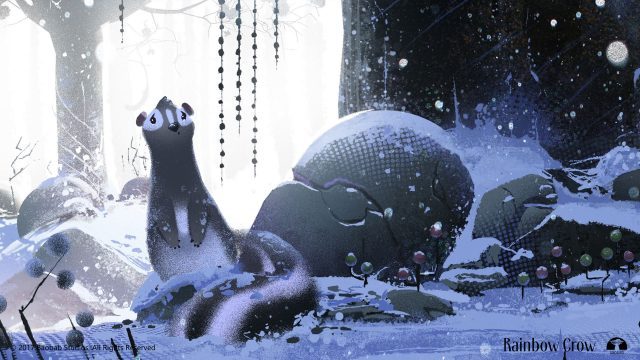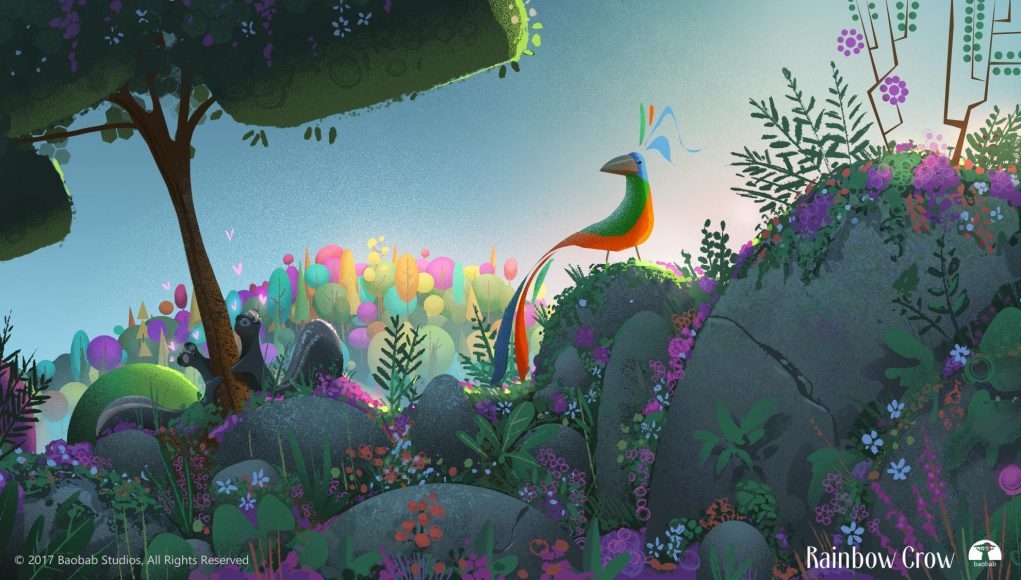John Legend is coming to VR. News of the multi-talented artist’s involvement in Baobab Studios’ latest, Rainbow Crow, spread last week. To recap, Rainbow Crow is an adaptation of a Lenape Native American tale, and Legend’s starring as the eponymous varicolored bird, writing and performing original songs and serving as executive producer.
He’s pretty involved, in other words. Baobab, meanwhile, is the studio behind INVASION! and ASTEROIDS!, both of which are helmed by CCO Eric Darnell who is known for writing and directing four Madagascar films and directing Antz (1998). I had the chance to sit down with Darnell and Baobab CEO Maureen Fan to preview Rainbow Crow’s first chapter on a Vive ahead of its premiere at the TriBeCa Film Festival’s Virtual Arcade.
The experience begins and ends on a patch of grass in the woods. Rainbow Crow’s forest circumscribes the viewer. The first chapter of a project that will ultimately encompass at least three situates you in the center of a small clearing, a sort of audience dais, and treats the enclosing flora as a stage, kliegs included. The question of how (and how much) to direct a viewer’s gaze remains an ongoing and well documented challenge in narrative VR experiences.
Darnell’s tack in the nearly five minute piece I demoed borrows from lighting techniques associated with theatre: spotlights, for lack of a better word, illuminate characters and their immediate surroundings and call the viewer’s gaze. Plants and animals end in soft, dithered edges, buttressing the environment’s visual continuity and pronouncing what Darnell described as Rainbow Crow’s “storybook” aesthetic: “We wanted something that felt magical, like a storybook” that you can walk into and inhabit.
The action proper involves two animal friends, a butterfly and a skunk named Becky, brought to your clearing by their hunt for summer flowers. Lighthearted shenanigans ensue when John Legend’s titular rainbow crow is heard singing and seen flying across the distant canopy. The scene ends as the story threatens to begin in earnest: winter arrives, snow falls, and the narrator, voiced by Randy Edmonds, warns of an imminent crisis.

The remaining chapters will run five-to-twelve minutes and are slated for release in 2017 at dates yet to be determined. Baobab’s Maureen Fan noted that runtimes have not been nailed down because they depend principally on where the “natural cutting points in the story are”; hence, too, the possibility of more than three chapters. Whatever the final length and number, the chapters’ acceptable time range is informed by “what consumers are saying makes them comfortable,” Fan said, adding, “It varies between headsets how long they want to be in there.” Since Baobab is committedly platform agnostic, the studio has to account for comfort across rigs.
Inevitably, future chapters will be more visually dynamic than the first, which was for its short duration inhabiting the same virtual scenery. There will be a cave the animals take shelter in and nominate a hero from, a crystal (or is it something else?) palace in the sky, outer space, and more, according to Darnell. Baobab says they’re also working to add a level of interactivity to every chapter. After the first ended, I demoed a build that included a version of this interactivity, which consisted of waving my Vive controllers around to produce snow flurries out their ends.

What I saw felt very much like an appetizer. It got me interested in where the story’s going, and in how interactivity and Legend’s songs will be incorporated, but it didn’t fill me up or leave me with a particularly sweet taste in my mouth. Next to Penrose Studios’ latest—which I had previewed earlier in the day—Rainbow Crow’s first chapter couldn’t help but feel short and static. I would not describe myself as having been transported, or made present, in other words. Given what I know about Baobab’s team, as well as what I was told about the story’s progression, however, I would scarcely be surprised if future chapters ably addressed the first’s issues.

It’s worth noting that this is the first filmic adaptation, VR or otherwise, of the Lenape Rainbow Crow story with a serious budget. A couple YouTube adaptations exist, the first of which is worth checking out if you’re curious about prior audiovisual versions of the tale.
For more on how Darnell’s approach to storytelling in VR has developed, listen to episodes #290 and #501 of Kent Bye’s Voices of VR podcast. As for Fan, she spoke with Bye in episode #258 during Baobab’s early days.







